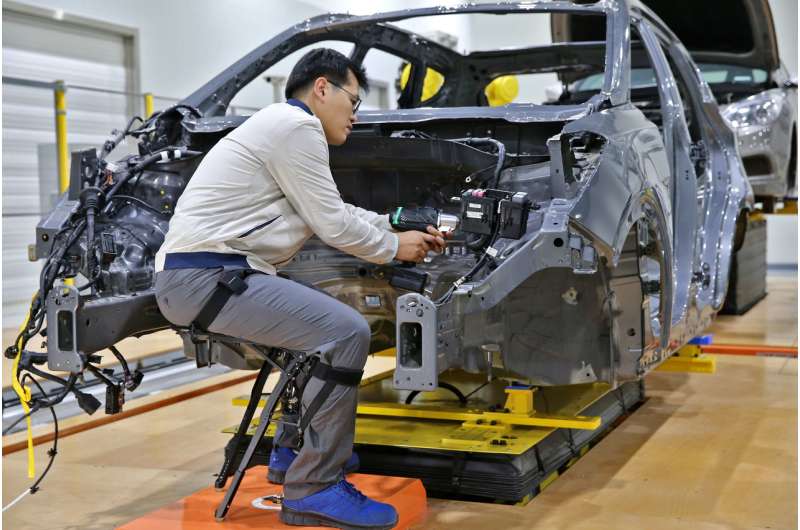Credit: Hyundai
Assembly line productivity goes nowhere north if aching joints from repetitive tasks kill required levels of stamina. Physical demands in certain tasks make the shoulder a sore spot, literally.
Overhead activity, for example, can result in aches and pains. "Some workers on the assembly line lift their arms an average of 4,600 times per day, or about 1 million times per year," reports stated.
As a major player in the car industry, Hyundai is taking notice. The carmaker is heating up efforts to evaluate the benefits of supportive exoskeletons that have been engineered for overhead and sitting tasks.
Will they increase efficiency? Lessen safety risks? Help prevent accidents?
Hyundai will now be looking at an upper body system, the Hyundai Vest Exoskeleton (H-VEX). "The soon-to-be introduced H-VEX exoskeleton is for workers in jobs that require a lot of arm lifting. The machine vest will support the upper body and protect neck and shoulder muscles," said Korea JoongAng Daily.
The car giant Hyundai will see what happens as the result of these robotic wearables in its factories, and the wearable will go on trial before the year is up, as the company plans to verify H-VEX's success with testing.
The Engineer noted they already looked at the Chairless Exoskeleton (H-CEX) for protecting knees and maintaining a sitting position. The H-CEX tests began recently.
Since September, the automaker has been testing the (H-CEX) at its North American factory, said Korea JoongAng Daily, describing it as "an assistive robot for workers who have to stay in a seated position throughout the day."
The H-VEX is designed to alleviate pressure on the neck and on the back. The Engineer said it adds 60kg of strength to the user when arms are used overhead.
So far, it is apparent the H-CEX showed good results. The goal is for reducing fatigue that comes from being in the same seated position for long periods; the H_CEX was said to reduce the use of waist and lower body muscles by 80 percent.
In the bigger picture, Automotive World reminded readers of Hyundai's serious focus on robotics.
Earlier this year, said the report, "Hyundai Motor Group identified Robot-Artificial Intelligence as one of five areas of future innovation and growth. The company established a designated robotics team in its strategic technology headquarters to focus on the development of related tech, and is expanding its cooperation with associated sectors."
The Hyundai focus ranges from wearable robots to service robots to micro-mobility.
Given that focus on robotics, it is not difficult to guess that the car giant has turned to technology collaborations with outsiders and just-auto.com's Graeme Roberts was able to fill his readers in:
"On 10 September, it initiated a strategic investment in the US-based artificial intelligence technology start-up Perceptive Automata to secure human movement prediction technology. The company is also cooperating with China's top vision technology equipped artificial intelligence start-up, DeepGlint." Beyond that, a fund has been created, said Roberts, for investing in "promising start-ups with competence in artificial intelligence and smart mobility."
Exoskeletons for industry use present ample opportunities for startups with relevant expertise; they do not have to confine their aspirations to suiting up Iron Man or signing on to the next big sci-fi movie out of Hollywood. When it comes to industry, the demand is for suits that can take some weight off the human worker.
Michael Koren in Quartz last year: "Yet entrepreneurs realized the real market opportunity was not building Sigourney Weaver's powered suit in Aliens, but simpler devices... Instead of batteries and motors, these devices strap on to workers bodies and transfer much of the weight to an exoskeleton through a system of wires and counterweights ... Objects feel almost weightless allowing workers to manipulate heavy objects using a fraction of the typical energy."
Will workers be glad for the suits' benefits or will they balk? A reader comment in The Engineer was a reminder that humans had the ball in their court as to how the technology would be introduced and managed. "As long as these devices are at worker option, do not interfere with workers natural movement or ergonomics, are not linked to increased productivity targets (unless incidental) and don't end up with the workers being treated like robots, then all good."
© 2018 Science X Network
























